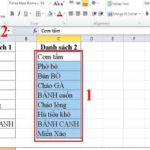The COUNTBLANK function is a popular function that is often used in Excel. This function is used to count the number of blank cells in a worksheet, which is familiar to those who frequently use Excel. However, if you’re not familiar with this function, let’s explore it in the article below on the FPT Shop website!
The concept of the COUNTBLANK function
In Excel, there are various functions for counting data and objects in a worksheet, including the COUNT, COUNTA, COUNTIFS, and COUNTBLANK functions. Each function has a common purpose of counting values, but each function has different requirements for the values to be counted.
The COUNTBLANK function is a function that counts the number of blank cells in a data range. Mastering this calculation function will help you become more proficient in Excel and easily combine the COUNTBLANK function with other calculation functions. That’s why you need to learn and master this type of function.
/fptshop.com.vn/uploads/images/tin-tuc/173224/Originals/ham-countbank-6.jpg)
Classification of counting functions in Excel
To count data in a worksheet, Excel offers 5 types of counting functions. The COUNT function counts the number of cells that contain numeric values in a specified range. The COUNTIF function is used to count the number of cells in a specific range that satisfy a specific condition. The syntax of the COUNTIF function is =COUNTIF(range, criteria), where the range is the data range to count and criteria is the condition you want to apply to count the cells.
The COUNTIFS function is also used to count the number of cells in a specific range that satisfy multiple conditions. Similarly, the COUNTIFS function has the syntax =COUNTIFS(range1, criteria1, range2, criteria2, …). Note that the COUNTIFS function allows a maximum of 127 ranges and 127 conditions to be counted.
One special thing about the COUNTIF and COUNTIFS functions is that these functions allow the use of the ? and * characters in the criteria, which represent any characters. The ? character represents any single character in a string. For example, “?at” will search for a 3-character string ending with “at”. The * character represents any string, including an empty string.
The COUNTA function is used to count the number of cells in a specific range that contain values, including numeric values, text, dates, etc. The COUNTBLANK function is used to count the number of specified empty cells that contain no values. The formula for the COUNTA function is =COUNTA(value1, value2, …), where value1, value2, … are the data range or values you want to count the number of non-empty cells. From Excel 2007 onwards, the maximum number of cells that can be counted is 255.
/fptshop.com.vn/uploads/images/tin-tuc/173224/Originals/ham-countblank-2.jpg)
How to use the COUNTBLANK function in Excel
The COUNTBLANK function has the syntax: =COUNTBLANK(range), where the range is the data range you want to count the empty cells. To understand this usage better, you can follow the example below: Use the COUNTBLANK function to count the empty cells for the following worksheet.
/fptshop.com.vn/uploads/images/tin-tuc/173224/Originals/ham-countblank-3.jpg)
First, enter the formula of the function: =COUNTBLANK(C4:C9) in the reference cell, then just press Enter to get the result. Note that the COUNTBLANK function counts only the number of empty cells, not cells that contain values such as numbers, dates, or text.
The COUNTBLANK function has a simple syntax and usage, but it has significant implications in statistics and calculations. However, not everyone fully understands this function, so you should learn and master the formula of the COUNTBLANK function to be able to combine it with other functions.
/fptshop.com.vn/uploads/images/tin-tuc/173224/Originals/ham-countblank-4.jpg)
Other methods to count empty cells in Excel
In addition to the COUNTBLANK function, there are a few other methods to count empty cells in Excel. For example, you can use the COUNTIF or COUNTIFS function with an empty string (“”) as the criterion.
Although there is no IF COUNTBLANK function in Excel, you can create your own formula by combining the IF and COUNTBLANK functions to count empty cells. First, check if the number of blank ranges is equal to zero by entering the logical expression: =IF(COUNTBLANK(range) = 0, “No blanks”, “Blanks”).
/fptshop.com.vn/uploads/images/tin-tuc/173224/Originals/ham-countblank-5.jpg)
Conclusion
In general, through this article, you have a better understanding of the application and usage of the COUNTBLANK function in Excel. This is a popular function that is widely used in statistics, so you need to master this function to improve your computer skills and perform simple tasks more easily.



































